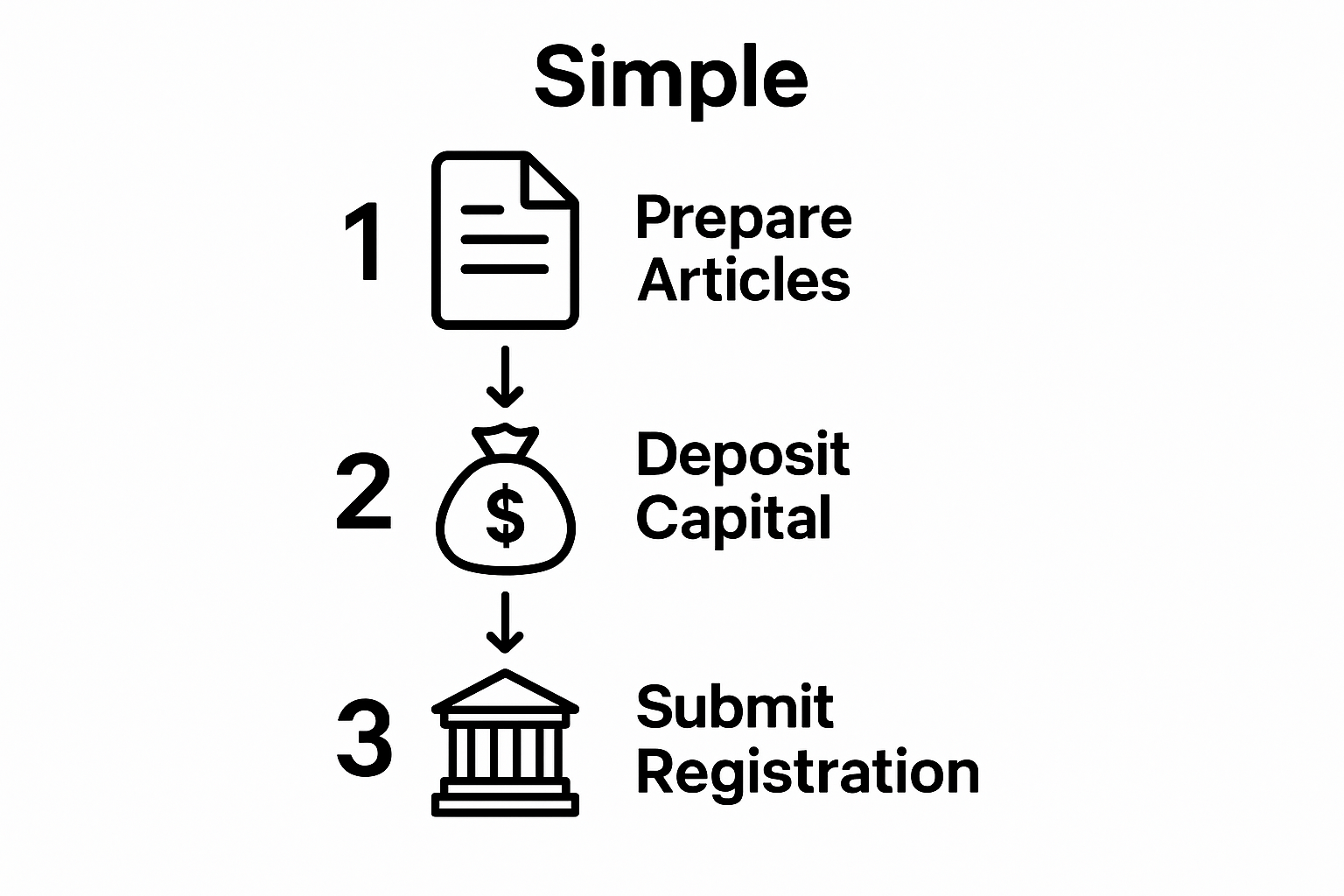Steps to Open Swiss Holding Company: A 2025 Guide
- Rolands Plotnieks
- Sep 12
- 10 min read
Updated: Oct 6

Setting up a Swiss holding company sounds like the gold standard for global business. With Swiss holding companies enjoying some of the world’s most favorable tax treatment, often lowering effective tax rates to below 8 percent, it makes sense that the top international players choose Switzerland as their corporate base. Most people think the hard part is just picking the right legal structure or filling out paperwork. The trick is, your long-term success comes down to steps most founders overlook long before they reach the registration desk.
Table of Contents
Quick Summary
Key Point | Explanation |
1. Evaluate Business Strategy Thoroughly | Analyze your business objectives to ensure alignment with a Swiss holding company’s strategic advantages tailored to your goals. |
2. Choose Appropriate Legal Structure | Select between Société Anonyme (SA) and Société à Responsabilité Limitée (Sàrl) based on your specific business needs and regulatory requirements. |
3. Prepare Comprehensive Documentation | Compile complete and precise legal documents to support your registration, ensuring compliance with Swiss regulations and industry standards. |
4. Secure Formal Registration | Submit required documentation to the commercial registry to obtain legal recognition and establish your company’s presence in Switzerland. |
5. Implement Compliance and Verification Protocols | Develop internal processes to maintain compliance with Swiss regulations and ensure ongoing transparency in operations and reporting. |
Step 1: Evaluate Your Business Strategy for Holding Company
Creating a Swiss holding company requires a strategic approach that goes beyond simple incorporation. This initial step focuses on comprehensive business strategy evaluation, transforming your vision into a structured, legally compliant framework that maximizes potential across international markets.
Strategic Purpose and Alignment
Your holding company strategy must transcend basic operational considerations. Begin by conducting a rigorous analysis of your primary business objectives, understanding how a Swiss corporate structure can provide strategic advantages. Determine whether your goals involve asset protection, tax optimization, international expansion, or investment portfolio management. Each objective requires a nuanced approach to structuring your Swiss holding entity.
Careful consideration of your specific business context will guide subsequent decisions. For international entrepreneurs, Swiss holding companies offer unique benefits such as robust legal protections, favorable tax treatments, and significant credibility in global financial markets. Assess your current business ecosystem, projected growth trajectories, and potential cross border investment scenarios to ensure alignment.
Comprehensive Structural Assessment
Beyond conceptual planning, you must evaluate practical implementation strategies. Analyze your existing corporate infrastructure, determining how a Swiss holding company integrates with current operations. This involves examining potential ownership structures, capital requirements, and regulatory compliance mechanisms. According to Harvard Business School Online, successful strategy development hinges on thoroughly understanding your organizational purpose and market opportunities.
Key verification criteria for this strategic evaluation include:
Clear definition of holding company purpose
Comprehensive analysis of potential tax and legal implications
Assessment of cross border investment capabilities
Alignment with long term corporate growth objectives
Successful completion of this step means you have a well defined, purposeful strategy that transforms the Swiss holding company from a theoretical concept into a strategic business asset. Your next phase will involve translating this strategic framework into concrete legal and financial preparations.
Step 2: Choose the Right Legal Structure and Name
Selecting the appropriate legal structure and corporate name represents a critical decision that will define your Swiss holding company’s operational framework, legal protections, and strategic capabilities. This step transforms your strategic vision into a concrete legal entity with precise parameters and potential for growth.
Legal Structure Considerations
In Switzerland, you have multiple legal structures to consider, each with unique characteristics tailored to different business objectives. The two primary options for holding companies are the Société Anonyme (SA) and the Société à Responsabilité Limitée (Sàrl). The SA offers more flexibility for larger investments and public offerings, while the Sàrl provides simpler management structures for smaller entrepreneurial ventures.
Carefully evaluate your specific requirements, considering factors such as minimum capital requirements, shareholder restrictions, and governance complexity.
Here is a comparison of the two main legal structures available for Swiss holding companies, summarizing their key characteristics to help you choose the most suitable option.
Structure | Minimum Capital | Shareholder Requirements | Suitable For | Key Advantage |
Société Anonyme (SA) | CHF 100,000 (20% paid up front) | No restriction on number of shareholders | Larger corporations, international investors | Greater flexibility, can issue bearer shares |
Société à Responsabilité Limitée (Sàrl) | CHF 20,000 (fully paid at incorporation) | At least one shareholder required | Smaller businesses, entrepreneurial ventures | Simpler management, lower capital requirements |
Naming and Registration Protocols
Your company name serves as more than a mere identifier it represents your brand’s first impression in the Swiss corporate landscape. Select a name that is linguistically appropriate, legally compliant, and strategically meaningful. Swiss regulations mandate that company names must be unique, distinguishable from existing registrations, and reflective of your business activities. Conduct a thorough name search through the Swiss Commercial Registry to ensure availability and prevent potential legal complications.
Key verification criteria for this step include:
Confirmation of legal structure alignment with business objectives
Comprehensive name availability check
Understanding of specific structural compliance requirements
Preparation of initial registration documentation
Successful completion means you have a clearly defined legal framework and a distinctive corporate name positioned for strategic implementation in the Swiss business ecosystem. Your next phase will involve detailed preparation of foundational corporate documents.
Step 3: Prepare Necessary Documentation and Capital
Preparing documentation and capital represents the foundational phase where your Swiss holding company transitions from strategic concept to legal reality. This critical step involves meticulous preparation of complex legal documents and precise financial arrangements that will define your corporate infrastructure.
Document Compilation and Requirements
Your documentation process demands comprehensive attention to detail. The articles of association emerge as your company’s constitutional framework, outlining fundamental operational guidelines. These documents must precisely articulate your corporate purpose, governance structure, shareholder rights, and capital allocation strategies. Draft these with exceptional clarity, ensuring they reflect both your immediate business objectives and potential future expansion scenarios.
The documentation package extends beyond basic articles. You will need to compile shareholder agreements, identification documents for all principals, proof of initial capital source, and detailed business plans. Each document must be professionally translated into one of Switzerland’s official languages German, French, or Italian to ensure legal compliance. Precision in document preparation eliminates potential bureaucratic obstacles and demonstrates your commitment to regulatory excellence.
Capital Allocation and Financial Preparation
Capital requirements represent a fundamental consideration in Swiss corporate formation. According to Swiss Federal Administration guidelines, minimum capital thresholds vary depending on your chosen legal structure. For a Société Anonyme (SA), you must secure at least CHF 100,000 in share capital, with a minimum of 20% (CHF 50,000) paid up front. International entrepreneurs should plan for additional financial buffers beyond these minimal requirements.
Key verification criteria for this step include:
Complete and legally authenticated documentation package
Verified capital funding sources
Comprehensive shareholder agreements
Professional translations of all foundational documents
Successful completion means you have a robust documentation framework and verified capital allocation strategy, positioning your Swiss holding company for smooth legal registration and future operational flexibility. Your next phase will involve formal submission and official registration processes.

Step 4: Register Your Holding Company with Authorities
Registering your Swiss holding company represents a pivotal moment where your strategic planning transforms into official legal recognition. This step bridges your preparatory work with formal governmental acknowledgment, requiring precision, patience, and thorough understanding of Swiss administrative protocols.
Navigating the Registration Landscape
The registration process demands meticulous attention to detail and comprehensive documentation. Your primary objective is to secure official recognition through the Swiss Commercial Registry, a process that validates your company’s legal existence. You will need to submit your carefully prepared documentation to the appropriate cantonal commercial registry office, typically located in the canton where your company will establish its primary headquarters.
Each canton may have slightly nuanced requirements, so understanding local regulations becomes crucial. Prepare for potential requests for additional clarification or supplementary documentation. Professional legal guidance can significantly streamline this complex process, helping you anticipate potential administrative hurdles and ensuring your application presents a comprehensive, compliant profile.
Submission and Verification Protocols
The submission process involves presenting your meticulously compiled documentation package, including articles of association, proof of capital allocation, identification documents for shareholders and directors, and other requisite legal forms. According to Swiss Federal Administration guidelines, foreign entrepreneurs must demonstrate a lasting positive economic impact, which means articulating how your holding company will contribute to the Swiss economic ecosystem.
Key verification criteria for this step include:
Complete and authenticated registration documentation
Verified capital funding sources
Comprehensive shareholder and director identification
Proof of economic contribution to Switzerland
Payment of applicable registration fees
Successful completion means obtaining your official Commercial Registry extract a critical document that confirms your holding company’s legal status. This extract serves as your company’s official birth certificate in the Swiss corporate landscape, enabling you to open bank accounts, enter into contracts, and commence formal business operations. Your next phase will involve finalizing administrative setup and preparing for operational launch.
Step 5: Open a Swiss Bank Account and Deposit Funds
Opening a Swiss bank account represents a critical milestone in establishing your holding company, transforming your legal entity from a theoretical construct into a financially operational organization. This step requires strategic planning, meticulous documentation, and a comprehensive understanding of Swiss banking protocols.
Selecting the Appropriate Banking Partner
Choosing the right Swiss banking institution demands careful consideration beyond mere financial reputation. You will need to identify a bank that specializes in corporate accounts for international holding companies, understanding the nuanced requirements of your specific business structure. Private banks and larger institutional banks like UBS, Credit Suisse, and cantonal banks offer different advantages, with some institutions demonstrating more expertise in handling international holding company accounts than others.
Your selection process should evaluate multiple factors including account maintenance fees, minimum balance requirements, international transfer capabilities, multilingual support, and the bank’s experience with companies similar to your corporate structure. Personal meetings with bank relationship managers can provide invaluable insights into their understanding of your specific business needs and potential growth trajectories.
Documentation and Fund Allocation
Preparing for your bank account opening requires assembling a comprehensive documentation package that demonstrates absolute transparency. You will need to provide your Commercial Registry extract, articles of association, shareholder identification documents, proof of capital source, and comprehensive business plans. According to Swiss Federal regulations, banks must conduct rigorous due diligence to verify the legal origin of your funds and confirm beneficial ownership.
Key verification criteria for this step include:
Complete corporate documentation package
Verified source of initial capital
Successful bank account opening confirmation
Initial capital deposit matching registration requirements
Signed banking agreements and compliance documents
Successful completion means establishing a fully functional corporate bank account that enables your holding company to conduct financial transactions, receive investments, and manage international fund transfers. Your next phase will involve finalizing operational infrastructure and preparing for active business engagement.

Step 6: Ensure Compliance and Verification of Operations
Ensuring compliance and verification of operations represents the critical final phase of establishing your Swiss holding company, transforming your legal entity from a theoretical construct into a robust, internationally recognized corporate structure. This step demands meticulous attention to regulatory requirements and proactive management of financial and legal obligations.
Navigating Regulatory Landscape
Compliance is not a one time event but an ongoing commitment to maintaining the highest standards of corporate governance. Your holding company must develop comprehensive internal protocols that align with Swiss regulatory frameworks, international tax standards, and anti money laundering regulations. This involves creating systematic documentation processes, maintaining accurate financial records, and establishing clear communication channels with relevant Swiss regulatory authorities.
Establishing a robust compliance infrastructure requires engaging professionals who understand the nuanced regulatory environment. Consider partnering with Swiss legal experts, tax advisors, and compliance specialists who can provide ongoing guidance and help you navigate the complex landscape of international financial regulations. Their expertise will prove invaluable in interpreting evolving legal requirements and ensuring your holding company remains fully compliant.
Verification and Reporting Protocols
Implementing a comprehensive verification system involves creating multiple layers of financial and operational oversight. According to Swiss Federal regulations, you must develop mechanisms for periodic financial reporting, beneficial ownership documentation, and transparent transaction tracking. This includes maintaining detailed records of shareholder activities, investment flows, and corporate financial movements.
Key verification criteria for this step include:
Comprehensive internal compliance documentation
Periodic financial and tax reporting mechanisms
Annual independent audit preparations
Transparent beneficial ownership records
Established communication protocols with regulatory authorities
Successful completion means creating a resilient, compliant corporate structure that can withstand rigorous international scrutiny. Your holding company is now positioned to operate efficiently, maintain legal integrity, and pursue strategic business objectives within the Swiss and global financial ecosystems.
The following checklist summarizes key verification criteria to ensure your Swiss holding company maintains ongoing compliance and operational transparency.
Compliance Requirement | Description |
Internal Documentation | Maintain comprehensive, up-to-date records for governance and decision-making |
Financial Reporting | Prepare and submit periodic financial and tax reports as mandated |
Beneficial Ownership Tracking | Keep accurate and transparent records of all beneficial owners |
Independent Audits | Arrange for annual audits as required under Swiss law |
Regulatory Communication | Establish and maintain regular communication with Swiss regulatory authorities |
Anti-Money Laundering Measures | Implement protocols to comply with anti-money laundering laws |
Tackle Swiss Holding Company Challenges with Confidence
Are you feeling overwhelmed by the legal complexity, documentation hurdles, and banking requirements involved in opening a Swiss holding company? This guide highlights how easily critical details like compliance verification, proper legal structure, and seamless capital deposits can delay your business plans or jeopardize your investment. If you want to secure the tax advantages, global credibility, and robust structure that Switzerland offers, you need an expert partner to walk you through every step from strategy to registration and ongoing compliance.

Do not let regulations or unfamiliar processes slow your momentum. Visit https://rpcs.ch today to discover how our team helps international entrepreneurs transform their Swiss holding company ambitions into reality. Our experts simplify document preparation, fast-track Swiss bank account setup, and proactively manage your compliance, so you can focus on growth and global opportunities. Get your holding company ready for 2025—reach out now for tailored guidance and a smoother launch.
Frequently Asked Questions
What are the key steps to establish a Swiss holding company?
To establish a Swiss holding company, you need to evaluate your business strategy, choose the right legal structure and name, prepare necessary documentation and capital, register the company with authorities, open a Swiss bank account, and ensure compliance with regulations.
What is the minimum capital requirement for a Swiss holding company?
For a Société Anonyme (SA), the minimum capital requirement is CHF 100,000, with at least 20% (CHF 50,000) required to be paid up front. For a Société à Responsabilité Limitée (Sàrl), the minimum capital is CHF 20,000, fully paid at incorporation.
How do I choose the legal structure for my Swiss holding company?
The two primary options for holding companies in Switzerland are the Société Anonyme (SA) and the Société à Responsabilité Limitée (Sàrl). Consider factors such as your business objectives, capital requirements, and shareholder management needs when making your choice.
What are the compliance requirements for a Swiss holding company?
A Swiss holding company must maintain compliance with regulatory requirements, which include periodic financial reporting, maintaining accurate financial records, and adhering to anti-money laundering regulations. Engaging professionals in legal and tax advisory can help ensure ongoing compliance.
